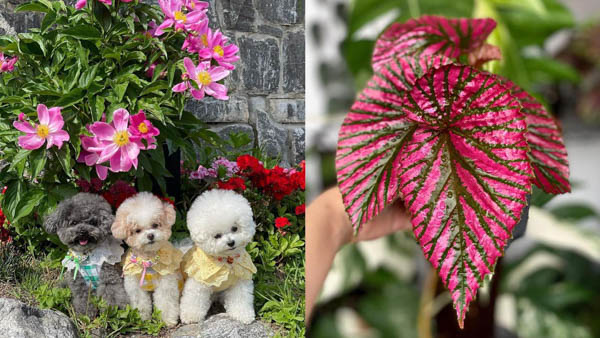You took your dog for a walk within the neighborhood. You went to a popular park, stunning garden, and other picturesque destinations around your community.
It was an excellent experience for sure. You keep your dog active and help it shed a pound. Likewise, you burn calories and allow you to maintain your physique.
More than that, walking with your buddy every day strengthens your connection.
After an hour or two, your adventure is finally over. But why is your pal starts vomiting, drooling, and showing some signs of irritation?
Of course, you may think your Poodle or German Shepherd is exhausted. But do not relax as your dog may have been exposed to poisonous flowers.
Whether your dog experiences difficulty breathing, vomiting, or drooling, do not leave it untreated for a few hours.
The best thing to do is contact a certified, licensed, and trusted veterinarian right away to avoid other severe complications. Take a deep breath, and do not panic.
Now, what flowers are poisonous to dogs? You will know the top 15 toxic flowers you should avoid in this guide. Let us begin!
1. Lilies

Calla, Peace, Peruvian, and other lilies are poisonous not only in dogs but also in cats.
Whether you see some Calla or Peruvian in your neighbor’s garden, find another route or place to play and exercise.
According to the Pet Poison Hotline, lilies are rich with oxalate crystals that can irritate the throat and excessive drooling.
The Japanese Show, Asiatic, Tiger, Day, and Easter lilies are more toxic to dogs. Studies have confirmed that ingesting a few petals can lead to kidney failure.
2. Lily of the Valley

Looks can be deceiving, and Lily of the Valley proves that. It is gorgeous, and it produces some addicting fragrance you cannot resist.
But no matter how attractive it is, Lily of the Valley is deadly to dogs and other animals.
Aside from the flowers, its entire plant is toxic. Experts report that Lily of the Valley is packed with glycosides that can reduce the heart’s ability to pump enough blood.
Exposure to Lily of the Valley can result in irregular pulse, stomach pains, blurred vision, diarrhea, and vomiting.
3. Dieffenbachia

The green leaves of dieffenbachia can take your terrariums to the next level.
But be wary. Like lilies and the Lily of the Valley, dieffenbachia is also toxic to dogs and cats.
Similar to other flowering plants in this list, dieffenbachia has varieties, and each consists of proteolytic enzymes, calcium oxalates, and other compounds that can result in irritation, intense burning, difficulty swallowing, vomiting, and excessive drooling, according to the American Society for the Prevention of Cruelty to Animals.
If you plan to use dieffenbachia for terrariums, look for better alternatives.
4. Hyacinths and Tulips

Tulips and hyacinths are famous for a reason. They are attractive and can catch your attention and interest in an instant.
However, they can put your dog’s life in danger. Ingestion and exposure to tulips and hyacinths can lead to lack of appetite, intense vomiting, drooling, depression, hypersalivation, and diarrhea.
What is the most poisonous part of the tulips and hyacinth? It is the bulb.
But that does not mean you cannot have tulips and hyacinths in your garden. You can have them in your yard but keep them away from your dogs.
5. Sago Palm

Commonly called cardboard palms, coontie palms, zymias, and cycads, the sago palm is harmful to pets.
What makes it toxic is that it contains cycasin that can affect your dog’s liver.
Yes, the Sago Palm leaves are out of range of a wandering dog and other animals. But a little bite can cause bloody stools, internal bruising, prompt vomiting, and urinary issues.
In other severe cases, your dogs may suffer from coma, seizures, paralysis, and even death, according to PetMD.
When you are in the park and have seen sago palm, you need to be extra careful.
6. Kalanchoe

Kalanchoe can be seen as a decorative plant in most homes in the US, and you would believe it is native to the country. But it is not. It originally came from Australia and South Africa.
Kalanchoe is one of the go-to flowering plants for many because it can blend in your home’s interior design perfectly, and you will appreciate its beauty during the long summer months.
Unfortunately, it is full of poisonous glycoside compounds. A few grams of kalanchoe killed a small calf.
7. Oleander

Who would not know oleander? Everyone loves it because of its highly decorative effect, making it popular in the western and southern United States.
Perhaps, you have lots of oleanders in your garden. But did you know that oleander is one of the most deadly flowers for your dogs?
Every part of the oleander plant is poisonous, according to Wag Walking, from the sap, seeds, nectar to fruit.
But the toxins in the stem are the most concentrated. If your dog has ingested oleander, it needs immediate medical attention.
8. Crocus

While there are many crocus types, the spring and late blooming crocuses are the most common variety.
Although the spring crocus is not extremely toxic, it can result in diarrhea and vomiting.
The late-blooming, also known as autumn crocus or meadow saffron, is much worse.
The Poison Garden confirms that the late-blooming crocuses can trigger renal failure in dogs and humans when ingested.
For many years, the crocus has been subject to research. It is also once used as a medicine for gout.
But with its potential side effects, the FDA banned the treatment.
9. Daffodils

The spring season has started. Daffodils are in full bloom, and it is relaxing to sit on your patio while taking a sip of your favorite and warm chocolate.
But the beauty of dancing daffodils is irresistible. Perhaps, you want to walk thru a garden full of daffodils.
But do not bring your Shih Tzu, Poodles, or other dogs there because daffodils are toxic.
Like hyacinths and tulips, they contain alkaline substances that cause abdominal pain, cardiac arrhythmia, diarrhea, and vomiting.
10. Rhododendron and Azalea

Indeed, a small bite of rhododendron or azalea will not lead to discomfort.
When large parts of the plant are ingested, it could trigger extreme vomiting and toxic shock, according to Poison.org.
The honey made from rhododendron and azalea plants can be harmful.
Often referred to as mad honey by the ancient people in Turkey, they are also fed to invading Romans, causing vomiting, confusion, and even death.
Also, watch out for your kids because they may get poisoned by azalea and rhododendron.
11. Amaryllis

Another flowering plant to avoid is the amaryllis. Each bulb is found to have compound lycorine that can lead to tremors, gastrointestinal distress, and lethargy.
While a small nibble from other plants can cause extreme discomfort, amaryllis is different.
Most canines need to ingest a high amount of amaryllis bulbs to see and experience some symptoms.
In addition to lethargy and gastrointestinal distress, amaryllis can cause drooling, respiratory distress, nausea, low blood pressure, vomiting, abdominal discomfort, and diarrhea.
12. Gladiola

Gladiola is another popular perennial plant. But it is toxic to your buddies if they eat the bulb and other parts of it.
In the US, gladiola is removed from the ground during winter. If you do the same thing, be extra careful.
The bulb is high in toxicity, causing seizures, lack of oxygen, heart murmur, liver problem, and kidney symptoms.
The symptoms of gladiola poisoning depend on dogs and the amount ingested. Contact the nearest veterinarian if necessary.
13. Baby’s Breath

Native to Asia and Europe, Baby’s Breath has been introduced in Canada and the northern part of the United States.
Commonly used in floral arrangements, Baby’s Breath is cultivated in most gardens as a bedding plant.
Its large taproot and seed production can be a nuisance in small, mid-sized, and large gardens.
What’s more, Baby’s Breath is toxic to dogs because of gyposenin.
When your dog is poisoned, symptoms include lethargy, sudden weight loss, depression, and more.
14. Chrysanthemum

Known as Shasta daisy, chrysanthemum is a brightly colored flower that can be a perfect and complete addition to your garden of any size.
Available in over 200 species, chrysanthemum also comes in different colors, including red, yellow, and orange.
They grow in summer or spring and start to bloom in the fall season. But is it pet-friendly?
Well, it is poisonous. It can produce severe allergic reactions in small dogs as well as cats.
15. Begonia

Begonia is beautiful. No wonder people keep it as houseplants. But it is poisonous to dogs.
If you have a curious Husky or Chihuahua, it is time to look for other safer and excellent alternatives.
If ingested, this plant can irritate the mouth and cause drooling.
When your dog swallowed bulbs or petals, let it eat and drink liquid foods to dislodge oxalate crystals in the digestive system.
The vet may also recommend anti-inflammatories to reduce the swelling in the throat. The best thing to do is to consult a licensed medical professional.
